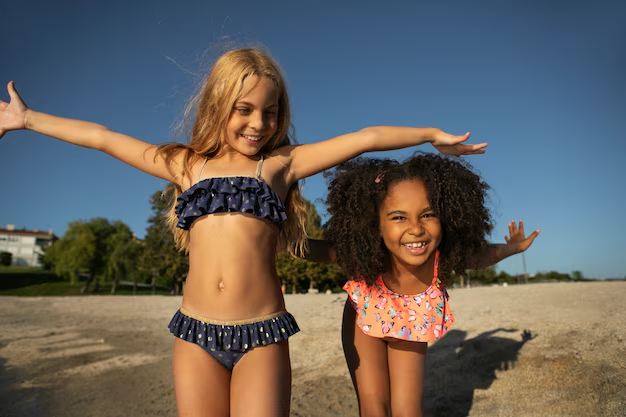1. Introduction to Bikini Culture
The bikini, since its inception, has been more than a mere two-piece swimsuit; it has evolved into a cultural icon encapsulating empowerment, fashion, and freedom. Originally created by French designer Louis Réard in 1946, the bikini was a garment that captured the liberating spirit of the post-war era. Over time, it has become a canvas for countless designs and an emblem of body positivity and confidence for girls and women embracing their individuality. Girls in bikinis are a common sight on beaches around the world, symbolizing both leisure and the affirmation of personal style. The versatility and boldness of the bikini continue to make it a preferred choice for sunbathers, swimmers, and fashion lovers alike.
2. The Empowerment and Body Positivity Movement
2.1. Bikinis as a Statement of Liberation
Donning a bikini often serves as a statement of liberation and empowerment. It’s a declaration of autonomy over one’s body and an express political act tying back to suffragette movements where swimwear was a visual protest against restrictive clothing. Nowadays, girls in bikinis can push back against societal standards, showcasing a range of body types confidently enjoying the sun and sea.

2.2. The Role of Bikinis in Body Positivity
The body positivity movement has found an ally in the bikini industry, which has begun to embrace inclusivity with sizes and styles designed for all body types. Girls in bikinis now celebrate body diversity, flaunting curves, marks, and all the natural variations that come with human bodies. The widespread acceptance and representation of all shapes and sizes in swimwear advertising and media further this goal of universal self-acceptance.
2.3. Overcoming Body Image Issues
Despite progress, body image issues persist, but the bikini has played a pivotal role in turning the tide. Being able to choose a bikini that suits one’s taste, fits comfortably, and makes one feel attractive has a profound impact on self-esteem. Initiatives encouraging girls of all sizes to wear bikinis and share their photos on social media under dedicated hashtags have fostered communities of support and empowerment.

3. The Fashion Influence of Bikinis
3.1. Bikini Trends Over the Decades
The beach bikini has been a dynamic piece in the realm of fashion. From the high-waisted bottoms of the ’50s to the string bikinis of the ’70s, to the diverse array of styles today, bikini trends have adapted to societal shifts while influencing beach fashion worldwide. Designers have continuously innovated, adding features such as cut-outs, intricate patterns, and sustainable materials to their collections, ensuring that girls in bikinis remain at fashion’s cutting edge.
3.2. Celebrity Impact on Bikini Fashion
Celebrities have significantly impacted the popularization of certain bikini styles. Icons like Brigitte Bardot and Ursula Andress have made indelible marks on bikini history, turning particular designs into must-have items. More recently, social media influencers and models have showcased new trends, inspiring a global audience and shaping the buying habits of bikini enthusiasts.
3.3. Integrating Bikinis into Mainstream Fashion
Beyond the beaches and poolsides, Teen bikinis have made their way into mainstream fashion. Bikini tops are now paired with skirts, jeans, and under jackets, highlighting the versatility of the garment. This blend of swimwear and daywear is testament to the bikini’s solidified status within the broader fashion industry, affirming its position as a cornerstone of summer apparel and beyond.

4. Social Dynamics and Bikini Culture
4.1. Bikinis and Social Perception
Bikinis have often been at the center of debates around modesty, sexuality, and public perception. While some view the bikini as emblematic of freedom, others see it through a more conservative lens. Societal attitudes toward girls in bikinis can reflect broader cultural mores and norms, which vary significantly across different regions and communities.
4.2. The Globalization of Bikini Culture
Despite diverse opinions, bikini culture has become globalized, with swimwear markets flourishing in countries with a variety of social and religious backgrounds. The universal appeal of bikinis transcends borders, signifying a collective desire for swimwear that embodies style and comfort. Through travel and cultural exchange, the bikini has become ubiquitous, with its presence on beaches around the world indicating a shared human experience of leisure and recreation.
4.3. Bikinis and Gender Dynamics
The bikini has long been a focal point in discussions about gender dynamics, often used to highlight issues surrounding the sexualization of the female body and the gaze of the observer. Activism and social movements have utilized the bikini as a tool for challenging gender stereotypes and advocating for women’s rights to choose what they wear without judgment or objectification.

5. Sustainability and Ethical Considerations in Bikini Production
5.1. The Rise of Sustainable Swimwear
As environmental awareness increases, the swimwear industry, including bikinis, is undergoing a transformation. Brands are now focusing on sustainable practices, using eco-friendly materials such as recycled plastics to create bikinis that appeal to environmentally conscious girls. These initiatives have given rise to swimwear that’s not only fashionable but also reduces the ecological footprint, addressing the demand for responsible production.
5.2. Ethical Manufacturing and Labor Rights
The bikini industry, much like the broader fashion industry, faces scrutiny regarding manufacturing practices and labor conditions. Ethically-minded consumers are looking beyond the aesthetics of bikinis to consider the conditions under which they’re made. Girls in bikinis are increasingly endorsing brands that are transparent about their supply chains and are committed to fair labor practices, further influencing industry standards.
5.3. Supporting Local and Artisan Bikini Makers
A growing segment of the bikini-wearing community is choosing to support small-scale artisans and local manufacturers. These consumers often find unique, handcrafted bikinis while helping to sustain traditional craftsmanship and local economies. This trend has led to a greater appreciation of the work behind each garment and encourages a more personal and thoughtful approach to swimwear shopping.
6. The Future of Bikinis and Swimwear Fashion
6.1. Technological Advances in Swimwear
The future of bikinis looks bright with advances in fabric technology and design. Cutting-edge materials that offer UV protection, enhanced durability, and improved fit are being integrated into bikinis. Smart textiles that change color with temperature or that offer hydrodynamic benefits are on the horizon, suggesting a new era where high-tech meets high fashion in swimwear.

6.2. Inclusive Sizing and Design Diversity
The industry is moving toward more inclusive sizing and design diversity, breaking away from the ‘one-size-fits-all’ approach. Brands are expanding their size ranges and offering styles that cater to a wide spectrum of body types, ensuring that every girl can find a bikini that makes her feel comfortable and confident.
6.3. The Importance of Individual Expression
As we look to the future, the importance of individual expression in swimwear remains paramount. Bikinis will continue to be a platform for self-styling, personal branding, and creative freedom. Girls in bikinis will not only be choosing swimwear for its function but also as a form of personal storytelling and identity, crafting their narrative through the bikinis they choose.
In conclusion, the bikini symbolizes more than just a piece of swimwear; it’s a garment rich in history, agency, and style. From its controversial beginnings to becoming a staple in fashion and a tool for empowerment, the journey of the bikini reflects significant societal trends and the ever-changing landscape of women’s fashion. As girls worldwide continue to don bikinis, they carry forward the message of personal freedom, body positivity, and the enduring joy of summertime fashion.
